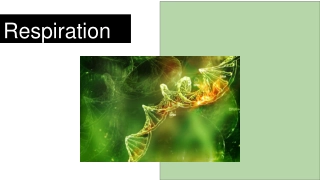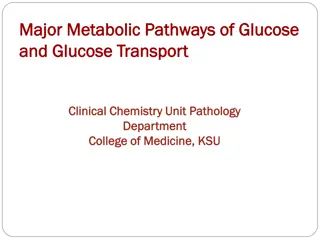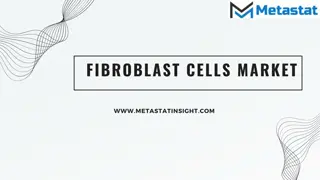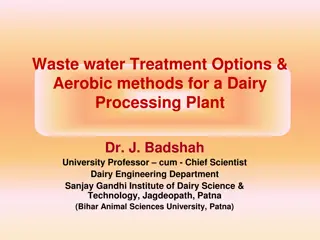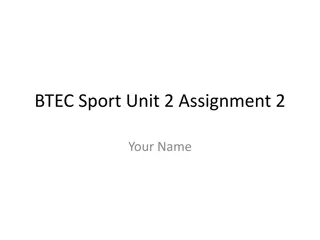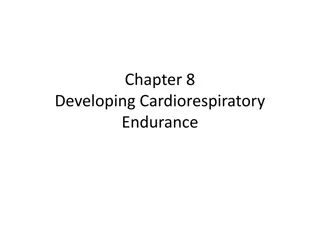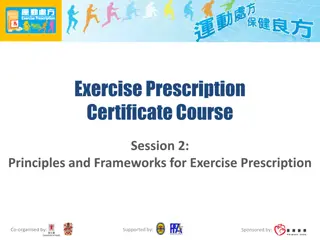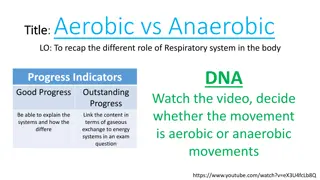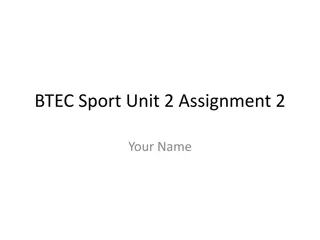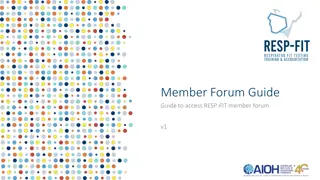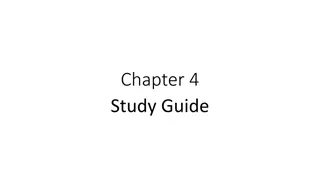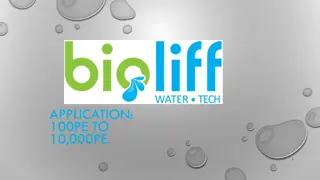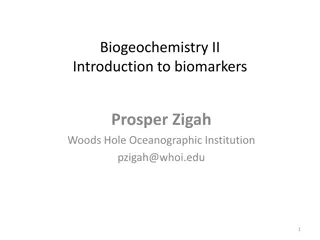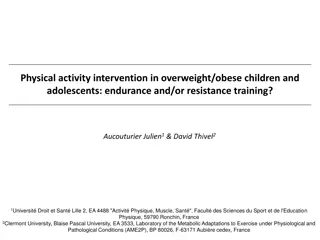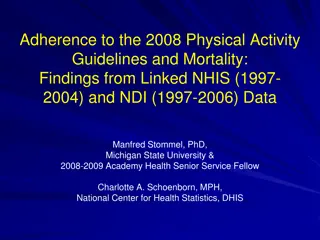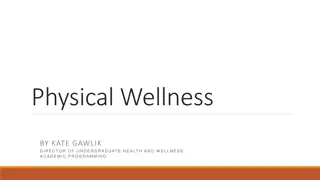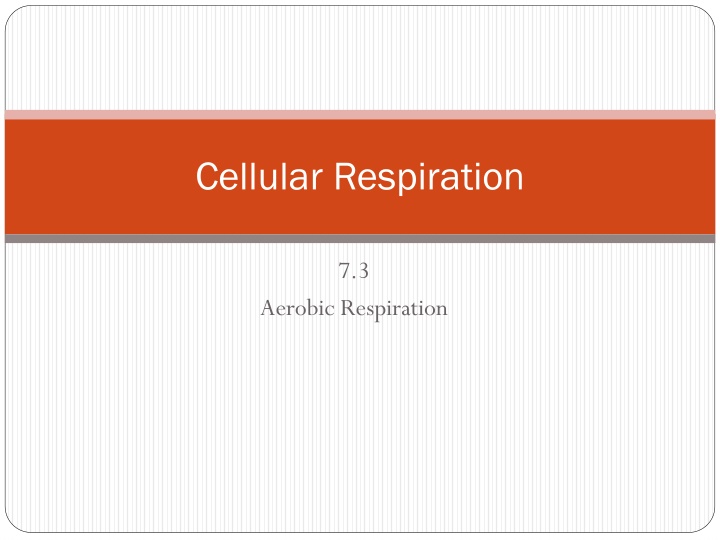
Aerobic Respiration and Cellular Processes
Explore the stages of aerobic respiration, from glycolysis to pyruvate oxidation, in this overview of cellular respiration. Learn how enzymes oxidize glucose, transfer electrons, and generate energy in mitochondria. Dive into the intricate processes that produce ATP for cellular functions.
Download Presentation

Please find below an Image/Link to download the presentation.
The content on the website is provided AS IS for your information and personal use only. It may not be sold, licensed, or shared on other websites without obtaining consent from the author. If you encounter any issues during the download, it is possible that the publisher has removed the file from their server.
You are allowed to download the files provided on this website for personal or commercial use, subject to the condition that they are used lawfully. All files are the property of their respective owners.
The content on the website is provided AS IS for your information and personal use only. It may not be sold, licensed, or shared on other websites without obtaining consent from the author.
E N D
Presentation Transcript
Cellular Respiration 7.3 Aerobic Respiration
Stages Aerobic Respiration Stage 1: Stage 2: Stage 3: Stage 4: 1. 2. 3. 4. Glycolysis occurs in _______________________ Stage 2 4 occurs in ________________________ - possess _____________________ membrane: outer membrane as well as an inner membrane (highly folded) - ____________________________ space between both membranes (fluid filled) - inner membrane contains mitochondrial __________________________ (protein-rich liquid that fills interior)
Aerobic cellular respiration: Overview Aerobic cellular respiration: Overview
Aerobic respiration: An overview A series of enzyme controlled reactions ______________________ is used to oxidize glucose ________________________ to form ___________ ________________________ to form ___________ During the oxidation of glucose: Electrons transferred to electron carriers, _________ and _________ Electrons then passed through an ________________ ____________________________ The ________________________ from the electrons will be used to pump _______________. The energy from the _____________________ of protons will be used to make _________.
Stage 2: Pyruvate Oxidation Recall: reactions of glycolysis produced TWO ________________________, TWO __________, and 2 ________________ - does not require _______ ; occurs in ________________________ Pyruvate Oxidation: chemical pathway that connects glycolysis to Krebs cycle 2 pyruvate molecules are moved from the cytoplasm to the ___________________ of the mitochondria ______________ is removed from each _____________________ molecule and released as a ____________________ product (1/3 of what you exhale)
Stage 2: Pyruvate Oxidation Cont. The remaining 2-carbon portions are oxidized by ______________; As a result, the NAD+ molecule gains two hydrogen atoms and the remaining ________________ molecule becomes ________________________ _________________________ (Co-A) attaches and forms ________________________ Acetyl-coA enters stage 3 (Krebs cycle) and NADH goes to _______________________ 2 ___________ diffuses out of the mitochondria and cell.
Stage 3: Krebs Cycle This is an _________ step and cyclic stage cyclic because one of the products of step 8, is a reactant in step 1 At the end of the Krebs Cycle, all __________ carbons have been oxidized to _____________ and released from the cell as metabolic _________________ All that remains is some free ____________________ in the form of ____________ and high energy ____________ and _______________ These energy carriers enter the ___________
Krebs Cycle: The Details Krebs Cycle: The Details Cycle occurs ________________ for each ______________________ molecule Acetyl CoA adds 2-carbons to ___________________, producing _______________________ Citrate loses a __________ molecule, and the resulting compound is ___________________, reducing NAD+ to _________________ Another CO2is ______________, and the resulting compound is oxidized, reducing NAD+ to NADH ADP is ___________________________ to _________ Two hydrogen's are transferred to ______________ to form __________________ Kreb Cycle 1. 2. 3. 4. 5. 6.
Krebs Cycle Overview 1 Glucose= EACH _____________________ molecule produced in glycolysis (2) must enter the Krebs Cycle Therefore the cycle occurs ____________________ for every _____________________ molecule
Stage 4: ETC _____________________________________: release the _______________________ they received during glycolysis and the Kreb s cycle to ETC - ______________________ of the ETC transfer the electrons and use the energy released to pump _____________________ ions (protons) Hydrogen ions (protons) are pumped from the _____________________ to the ___________________ space Creates a _______________________ gradient
Stage 4: ETC Cont. ____________________: final electron _________________ at the end of the ETC - oxygen accepts the electrons, combines with ___________ and becomes __________________ The accumulated hydrogen ions (protons) diffuse back into the matrix through _________________________________ -The energy released from the diffusion fuels the formation of _____________ (by pumping H+ ions into intermembrane space) ETC: - __________________ delivers electrons continuously - __________________ delivers ____________________ energy electrons in different place than NADH (cannot pump as many H+ ions) Electron Transport Chain animation Electron Transport Chain Electron Transport Chain
Stage 4 Cont: Chemiosmosis H+ ions accumulate in ________________________ space from ETC - creates an _________________________ gradient H+ ions (protons) move from intermembrane space to ___________________________________ - energy in gradient forces them through Energy ________________________ as H+ ions pass through = binds ADP with Pito produce _________! Energy removed from 1 NADH = ______ ATP s; 1 FADH2= ______ ATP s Oxidative _________________________________: Because the energy needed to add the _______ group to ADP is derived from the ___________________ of a glucose molecule aka oxidative ATP synthesis
Final Points Final Points ATP is now sent to the _______________________ to be utilized by the cell All stages are dependent on __________________ for the production of ____________________ Last stages are dependent on the availability of _______________________ (from food glucose) and _______________________

